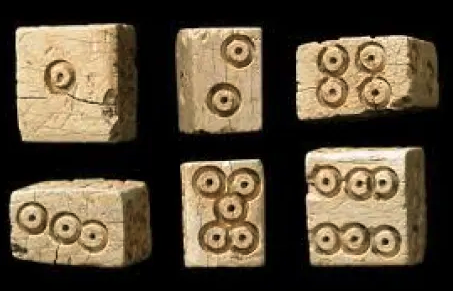Difference between revisions of "Template:POTD protected"
Occultwiki (talk | contribs) |
Occultwiki (talk | contribs) |
||
| Line 1: | Line 1: | ||
{| role="presentation" style="margin:0 3px 3px; width:100%; text-align:left; background-color:transparent; border-collapse: collapse; " | {| role="presentation" style="margin:0 3px 3px; width:100%; text-align:left; background-color:transparent; border-collapse: collapse; " | ||
|style="padding:0 0.9em 0 0;" | [[File: | |style="padding:0 0.9em 0 0;" | [[File:Egyptian Die.png|300px|thumb|]] | ||
|style="padding:0 6px 0 0"| | |style="padding:0 6px 0 0"| | ||
'''[[ | '''[[Cleromancy]]''' is a form of sortition (casting of lots) in which an outcome is determined by means that normally would be considered random, such as the rolling of dice, but that are sometimes believed to reveal the will of a deity. | ||
Many cultures around the world have used casting lots as a form of [[divination]] since ancient times, and there is no single established tradition for the practice. The [[Urim and Thummim]] were a form of [[oracle]] used to make decisions by the [[Judaism|Hebrew]] High Priest. In 98 AD, Tactus described the Germanic practice of casting lots through the use of wooden [[rune]]s with symbols carved upon them. | |||
<p><small>Photographer: | In China, the [[I Ching]] descended in part from the oracle bone divination system and grew over time into a rich literary wisdom tradition that was closely tied to the philosophy of yin and yang. I Ching practice is widespread throughout East Asia, and commonly involves the use of coins or sticks of yarrow. | ||
<p><small>Photographer: Unknown</small></p> | |||
[[:Category:Images|'''(More Images)''']] | [[:Category:Images|'''(More Images)''']] | ||
<div class="potd-recent" style="text-align:right;"> | <div class="potd-recent" style="text-align:right;"> | ||
Revision as of 21:28, 19 March 2024
|
Cleromancy is a form of sortition (casting of lots) in which an outcome is determined by means that normally would be considered random, such as the rolling of dice, but that are sometimes believed to reveal the will of a deity. Many cultures around the world have used casting lots as a form of divination since ancient times, and there is no single established tradition for the practice. The Urim and Thummim were a form of oracle used to make decisions by the Hebrew High Priest. In 98 AD, Tactus described the Germanic practice of casting lots through the use of wooden runes with symbols carved upon them. In China, the I Ching descended in part from the oracle bone divination system and grew over time into a rich literary wisdom tradition that was closely tied to the philosophy of yin and yang. I Ching practice is widespread throughout East Asia, and commonly involves the use of coins or sticks of yarrow. Photographer: Unknown |
